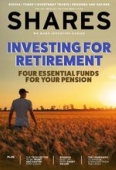Archived article
Please note that tax, investment, pension and ISA rules can change and the information and any views contained in this article may now be inaccurate.
How to build your first investment portfolio

In the world of investing, the future is unknown leaving investors to make their collective ‘best guesses’ as to what is most likely to happen.
It’s not unlike the weather with some days providing glorious sunshine and others a torrential downpour. In other words, it pays to take pack an umbrella as well as shorts and a hat.
Uncertainty is best tackled by choosing investments with different return expectations and different risks. Ideally you want to smooth out returns with some investments going up as other fall, rather than having all your eggs in the same basket.
Ryan Hughes, head of active portfolios at AJ Bell, says that one of the mistakes that beginners make is that they act like a collector, buying investments without regard to the way that each fit into the portfolio. Each investment should bring something different. The aim is to achieve the highest returns with the lowest risk.
This article will focus on building a portfolio using passive funds because they are a good way for first time investors to achieve diversification at competitive price. They enable you to get exposure to thousands of companies and bonds by buying just a few products.
Asset Allocation
This involves deciding what proportion of each asset, such as shares, bonds, and cash represent in the portfolio. One way of thinking about this is to divide assets into either stability or growth.
For example, cash held with a bank, assuming the amount is below £85,000, is protected by the government and safe. While this provides a high level of stability, any money you park there will attract very low rates of interest and therefore offer low growth. A typical UK bond fund such as the Lyxor FTSE Actuaries UK Gilts Fund (GILS) has a yield of 2.2%.
One important thing to mention here is the role that reinvesting income plays in growing capital and meeting your financial goals. By reinvesting interest received, you are effectively growing your capital in a smarter way, because your interest is added to your original capital, which in turn attracts more interest.
Over time, whether reinvesting interest from bonds or dividends from shares, it always pays to reinvest income and over long periods of time it can make a huge difference to your returns.
Adding more stability to a portfolio usually means accepting lower growth and so asset allocation really comes down to your personal preference and how much risk you are willing to accept, as well as your personal financial circumstances.
Cash and government bonds provide more stability, while
UK shares and UK corporate bonds offer less stability and more growth.
Over time, UK shares have provided average annual returns around 6%, which includes reinvested dividends, while government bonds returned just under 3%, with cash around 1.5%, according to the Barclays annual Equity Gilt study.
If you are relatively young, with potentially 30 years of investing in front of you, it can make sense to allocate more of your portfolio towards growth assets such as UK and global shares and even corporate bonds, and less in more stable bonds and cash. An example of a UK stock-based fund is iShares Core FTSE 100 (ISF).
Armed with information about potential returns, your time frame and attitude to risk, you can begin to structure the best asset allocation to suit your needs. It might be helpful to think in ranges rather trying to be very precise. For example, you may decide on a target range of say 50% to 65% in shares and 35% to 50% in bonds.
Be sure to check the next part in this series when we will address how to maintain a portfolio and discuss when and how to re-balance it through time.
A good starting point and efficient way to get exposure to a broad class of shares is to think globally and consider one of the products that track the MSCI World index. This gives an investor access to thousands of companies based across the developed world. An example of a global shares fund is the Fidelity Index World Fund (BJS8SJ3).
Once you have decided on the right mix to suit your needs, you have in effect created a core well balanced portfolio. With time and experience more specialist funds can be added to the mix. Think of it as a solid core surrounded by smaller specialist satellites, which provide different growth opportunities.
For example UK corporate bonds might be added as a growth satellite to the core, such as iShares GBP Corporate Bond (SLXX).
You might also consider including other assets to the mix like property, infrastructure or commodities. Commodities exposure is possible through products such as iShares Diversified Commodities Swap (COMM).
Just remember, each new investment should be considered in the context of what extra dimension it brings to the portfolio.
Important information:
These articles are provided by Shares magazine which is published by AJ Bell Media, a part of AJ Bell. Shares is not written by AJ Bell.
Shares is provided for your general information and use and is not a personal recommendation to invest. It is not intended to be relied upon by you in making or not making any investment decisions. The investments referred to in these articles will not be suitable for all investors. If in doubt please seek appropriate independent financial advice.
Investors acting on the information in these articles do so at their own risk and AJ Bell Media and its staff do not accept liability for losses suffered by investors as a result of their investment decisions.

 magazine
magazine









